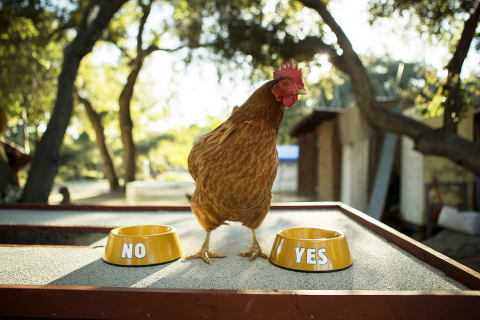
Image source: www.chickenfries.com
Burger King has a new promotion going: a live chicken, named “Gloria”, will travel to “select” Burger King locations across the U.S. and, by pecking at one of two food bowls marked “yes” or “no”, will determine whether or not that location will serve “chicken fries“, which are strips of chicken made up to look like french fries.
Since Gloria is a chicken, she has no grasp of the metaphysics of what she is doing: “deciding” whether or not, say, 500 of her fellow chickens will be turned into “fries” rather than chicken sandwiches on that day, based on her (possibly) random actions. All she knows is that she pecks the bowls, and gets food. I am not a chicken, and I find the image of a chicken deciding the fates of its fellows obscene. It’s a little like the happy painted pigs you see on the signs at barbeque restaurants, merrily encouraging guests to eat them and their friends. (What would Burger King do if Gloria pecked “no” at every stop? Held up a little sign that said “GO VEG”?)
I am also interested in that, as a being with a name, Gloria is Not Food, and is afforded the status due a named chicken: an “expert handler”, a “plush coop” and a “custom decision-making stage” from which to issue her decrees. Note also that Gloria is very unlike the chicken hoi polloi which are used in the fries: according to her web site, she is a “three-year-old Rhode Island Red chicken”. She has already lived nearly twenty times longer than the five-to-nine-week-old hybrid, white-feathered “broiler” chickens Burger King (likely) uses in their nuggets and sandwiches. She is from “Starlight Ranch, in Lake Elsinore, CA”, a facility so small even Google can’t find it. Why not choose a representative factory farm chicken from one of the big broiler producers? (Oh, yeah, they’re crippled, have no feathers, and die early of respiratory diseases. Not a good mascot.)
What message are we supposed to take from this? “Watch as the random actions of a factory farm chicken’s privileged cousin determine what shape your meat will be”? I have been led to understand that Burger King is at the forefront of what we must, alas, call the fast food revolution toward eventually, someday, provided it is financially feasible, possibly being slightly nicer to the animals we eat. I am not certain this advertising campaign fully supports that theory. (On the other hand, I certainly noticed it, so, in that regard, it worked perfectly.)
(From the primordial television series of The Hitchhiker’s Guide to the Galaxy)








